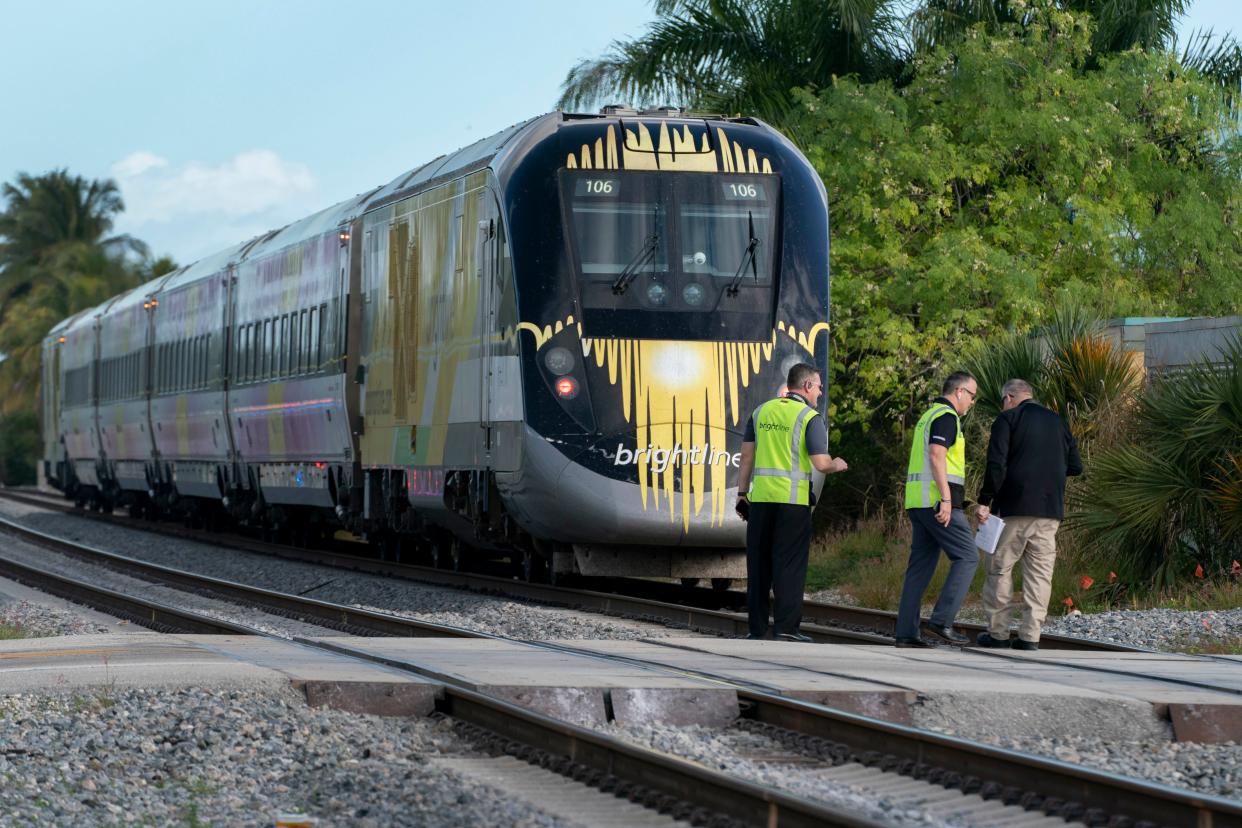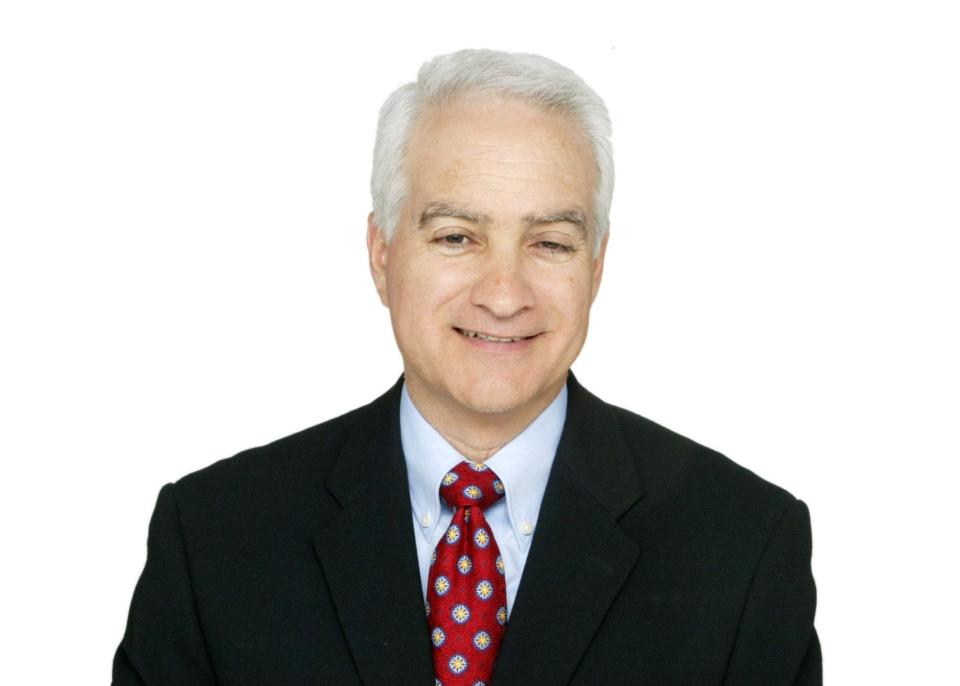South Florida drivers, pedestrians still a menace to fast Brightline trains | Frank Cerabino

It just might be that South Floridians are too reckless or depressed to have a fast passenger train zipping through our communities on a regular basis.
The evidence keeps mounting. After shutting down for 20 months during the COVID-19 pandemic, Brightline, the train that operates on the Florida East Coast tracks between Miami and West Palm Beach, gingerly began inching back to service.
Classroom cameras? New assault on Florida public schools: Proposed mandatory recording of K-12 teachers | Frank Cerabino
Where's your medical degree? Dr. DeSantis strikes again, now telling asymptomatic Floridians not to get tested | Frank Cerabino
So much for accountability: Boynton Beach police hide behind Marsy's Law in dirt-bike boy's fatal traffic stop | Frank Cerabino
On an engineer training run in July, a pedestrian was struck and killed on the tracks.
Cars on tracks a continuing problem
And on the first day back to customer service in November, a train struck a car in Pompano Beach that was stopped on the tracks, injuring the 71-year-old grandmother who was driving the vehicle, but not her 1-year-old granddaughter traveling with her.
Later in the month, a Brightline train struck a golf cart left on the tracks in Dania Beach.
That was followed by three pedestrians in separate incidents being struck and killed by trains in a one-week span last month. Those fatalities happened in North Miami Beach, Hollywood and Fort Lauderdale.

On Dec. 30, a Brightline train struck a Tesla stopped on the tracks in Lantana. The three people in the car were injured and driven to a trauma center.
A few hours later that same day, two people were killed at an Aventura crossing after the driver drove around the red-light-blinking crossing arms of the gates in an attempt to beat the train.
So far this month, a pedestrian was struck and killed by a train in Boynton Beach on Jan. 5. And on Thursday, a Ford SUV got caught on the tracks between the lowered crossing arms at an intersection near Miami’s Wynwood neighborhood, when it was struck by a passing train. The driver and her passenger were taken to a hospital.
Collisions with pedestrians and cars have haunted Brightline since its inception more than three years ago.
Train designed to speed through area
The whole selling point of Brightline has been to create a higher-speed train with a minimum of stops in order to get people from South Florida to Orlando more quickly than they could travel by car.
By going just shy of 80 miles per hour on the Florida East Coast Railway tracks, tracks that cut through the downtown areas of South Florida’s coastal cities, Brightline could take travelers from Miami, Fort Lauderdale or West Palm Beach to Orlando in just a couple of hours.
That’s the pitch. The reliance on those quick trains, though, didn’t account for the inexhaustible supply of dangerous drivers in South Florida and the numbers of homeless people finding refuge near the tracks.
Trail runs: Brightline will run empty trains along a 130-mile route starting Monday. Here's why.
Previously: Brightline train hits, kills person walking along track in Boynton Beach
More Brightline crashes: Brightline train crash injures three in Lantana, first of two crashes Thursday morning
They have given Brightline the dubious distinction of having the highest death rate among the nation’s 821 railroads, an Associated Press analysis in 2019 showed.
Brightline’s one death for every 29,000 miles traveled was significantly greater than South Florida’s other passenger rail service, Tri-Rail, a slower-moving train with a death rate of one death for every 110,000 miles.
Brightline responded to this safety issue in numerous ways.
It began an education campaign that included mailing safety flyers to homes along the train’s corridor. It extended fencing to keep pedestrians away from the tracks, and it paid for “safety ambassadors” to stand near intersections to warn motorists and pedestrians to keep away from the tracks when the trains approached.
The company has installed infrared detectors to warn engineers about people or vehicles in crossings and plans to test the use of drones and red-light ticket cameras.
In the more than 50 fatalities associated with Brightline trains, none of them have been blamed on operator error or faulty equipment, and many of the deaths, especially the pedestrians, have been attributed to suicide.
Brightline has inadvertently highlighted Florida’s problem of untreated mental illness in a state that currently has a $15 billion budget surplus.
Brightline's next phase awaits
This month, Brightline will start running empty trains through the Treasure Coast toward Cocoa Beach on a 130-mile stretch of track. It’s part of the second phase of Brightline’s plan to eventually connect the trains to an already-built terminal at Orlando International Airport.
After that, another phase calls for expanding the track westward toward Tampa, completing a connection that will link South Florida stops to both Orlando and Tampa.
During the testing phase of the trains through the Treasure Coast, Brightline plans to run the daily engineer training runs at the slower freight-train speed.
But once the service is operational next year, trains going north of West Palm Beach are expected to run faster than 100 miles per hour on less populated stretches of track.
Let us pray.
fcerabino@gannett.com
@FranklyFlorida
This article originally appeared on Palm Beach Post: South Florida pedestrians, drivers still a menace to Brightline trains

